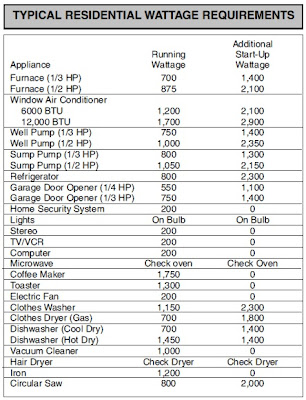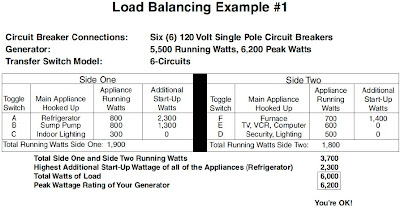Reliance Controls Transfer Switch: Installation and Operating Instruction–Part I
About Generators And Transfer Switches
Generators and
transfer switches are dependent on one another as a system to power your home
in a power out situation. The Reliance Controls transfer switch system is
needed because 1) your portable generator is very powerful and the power it
creates must be safely controlled to protect you and your electric utility
provider, and 2) even with all of its power, your generator probably cannot
power all of the electrical circuits and devices in your home without help from
a transfer switch with load management capabilities.
The Reliance
Controls transfer switch is designed to let you control and distribute your
generator’s power. It correctly distributes the power from your portable
generator to your home circuitry through your electrical load center. It also eliminates
the need for messy cords running to your electrical appliances through open
doors and windows. The Reliance Controls transfer switch working with your
generator takes the worry and inconvenience from power outage situations.
The Reliance
Controls transfer switch distributes the power from your generator through its
toggle switches to the corresponding selected branch circuits that power the
major appliances you choose to operate during a power outage (such as your sump
pump, refrigerator or furnace). However, because each of these branch circuits
may power several other electrical devices other than your major appliances,
such as the items plugged into wall sockets and permanently installed lighting,
we recommend that you do a little pre-planning by:
1. Picking the key
electrical appliances you want to power in an emergency.
2. Finding the
essential circuit breakers that control these devices.
3. Creating a map of
all of the other electrical devices plugged into or wired into these circuits.
During a power
outage, you can run your generator and transfer switch system in two ways:
1-
You can set up your
transfer switch to run all of its circuits at the same time once you flip the
toggles to the GEN position.
2- You can also use the
load management function of the Reliance Controls transfer switch that allows
you to alternate the devices you choose to run at any given time. If your
generator is running at or near its maximum output, selected circuits can be
switched off and others can be switched on for brief periods of time. For
example, you can run a microwave oven for a brief period from the transfer
toggle switch that controls your microwave circuit, if you first turn off the
transfer switch toggle switch that controls your furnace—for that same brief
period.
Key Components
Of The Reliance Controls Transfer Switch And Power Transfer Kit
Your Reliance
Controls transfer switch is unique in two ways:
1) It has a patented
internal wiring compartment which eliminates the need for the installation of
additional junction boxes.
2) It has a
removable front panel which allows a power inlet to be easily inserted to allow
a power cord to be plugged directly into the transfer switch with a longer
power cord. Although this is not the installation addressed by the 3006 HDK Kit, such an installation may be desirable
depending on your situation.
Pre-Installation
Planning Of The Generator Load
Before you begin
installing your Reliance Controls transfer switch system, you need to create a
plan for the appliances you choose to run during a power outage. To do this,
it’s helpful to first know how your generator produces power. If your generator
has four-prong twist-lock 20 or 30 Amp output receptacles, and is set-up for
home stand-by operation, it likely will produce 120/240 Volt power, or power similar
to your electrical utility. This type of power generation is useful as it: 1)
allows common 120 Volt circuits, such as lights or small appliances, to be
operated, and 2) allows two 120 Volt circuits to be linked together to operate
a 240 Volt device, such as a well pump.
Because of the way
in which larger portable generators are designed, they generate power in two
equal halves. A generator which has output of 5000 continuous running watts,
for example, generates power from two 2500 watt “sides”. In setting up a
transfer switch to get the most power from your generator, it is desirable to
“balance the load” between the two halves of your transfer switch, or the left side
and the right side. Devices which will consume the most of the generator’s
wattage should be divided between the two sides. Load balancing is shown in the
following figure. For example, on the 6-circuit transfer switch shown in the
figure, consider wiring the breaker controlling the refrigerator to toggle
switch A, the furnace breaker to toggle switch B, the sump pump breaker to
switch E and the breaker controlling your TV and VCR to toggle switch F. You
may want to reserve switches C and D to be linked with a handle tie and wired
to a double pole breaker controlling, for example, a 240 Volt well pump.
The Residential
Wattage Requirements Table below shows sample wattages used by typical
household appliances and can help you plan the setup of your transfer switch.
Use the running watts of your appliances rather than starting watts when
dividing them between the two halves of the transfer switch. Check your
appliances for actual wattage requirements if possible.
Your Reliance
Controls transfer switch also allows you to manage the load on your generator
manually by switching appliances on and off as you need them, so the capacity
of either half of your generator is not exceeded. However, if you prefer not to
manage your transfer switch loads manually, leave a buffer equal to the largest
start-up wattage requirement of all of the appliances you are going to run
continually when doing your calculation. This buffer, along with the peak
wattage of your generator, will allow for the periodic motor start-up of any
one large appliance, such as your refrigerator. If your transfer switch is
equipped with watt meters, you can visually monitor the amount of wattage being
used by the appliances your generator is powering at any time.
Examples of load balancing
calculations are shown on the following figures. Use these to create your own
plan.
This is the end of
Part I of this important issue, in the next part (Part II), we will discuss in
details the installation and operating instructions of Reliance Controls
Transfer Kit Model 3006 HDK. This discussion will be illustrated with detailed
figures and videos. Till we meet again!








Comments
Post a Comment
If this article is helpful for you, please leave a comment.